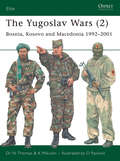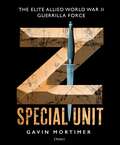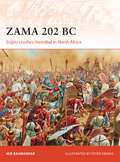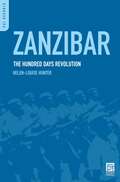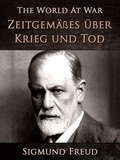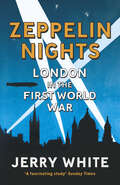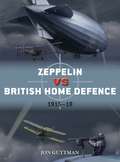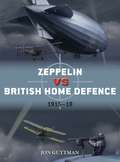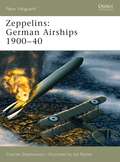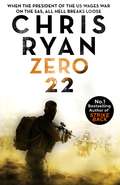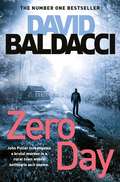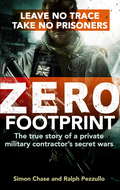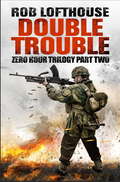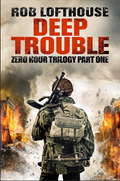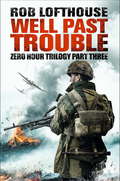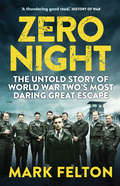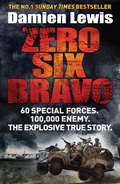- Table View
- List View
The Yugoslav Wars: Bosnia, Kosovo and Macedonia 1992–2001 (Elite #146)
by Nigel Thomas Darko Pavlovic K MikulanFollowing the death of the Yugoslavian President Tito in 1980, the semi-autonomous republics and provinces that he had welded into a multi-cultural nation in 1945 slid gradually towards separation. For ten years following 1991, the world watched in horror as a series of bloody wars ripped a modern European state apart, and the intolerable spectacle eventually forced international intervention. Illustrated with rare photos and colour uniform plates, this second of two volumes by experts on the Balkan region offers a concise breakdown of the indigenous forces involved in Bosnia-Herzegovina, Kosovo and Macedonia.
Z Special Unit: The Elite Allied World War II Guerrilla Force
by Gavin MortimerLeading expert Gavin Mortimer tells the remarkable origin story of a wartime special forces unit that defied the odds.Z Special Unit, one of the most intrepid but arguably the most unsung of Allied Special Forces of the Second World War waged a guerrilla war against Japan for two years in the south-west Pacific. On some of their 81 operations Z Special Unit slipped into enemy harbours in canoes and silently mined ships before vanishing into the night; on others they parachuted into the dense Borneo jungle to fight with headhunters against the Japanese and on one occasion they landed on an Indonesian island and smuggled out the pro-Allied sultan from under Japanese noses. The Japanese weren't the only adversary that Z Special Unit encountered in the brutal terrain of the Pacific. In the mango swamps of Borneo and the dense jungle of Papua New Guinea they were faced with venomous snakes, man-eating crocodiles and deadly diseases. But it was the enemy soldiers who proved the most ruthless foe, beheading those Z Special Unit commandos who fell into their hands.Drawing on veteran interviews as well as operational reports and recently declassified SOE files, Gavin Mortimer explores the incredible history of this remarkable special forces unit and the band of commandoes that defied the odds.
Z Special Unit: The Elite Allied World War II Guerrilla Force
by Gavin MortimerLeading expert Gavin Mortimer tells the remarkable origin story of a wartime special forces unit that defied the odds.Z Special Unit, one of the most intrepid but arguably the most unsung of Allied Special Forces of the Second World War waged a guerrilla war against Japan for two years in the south-west Pacific. On some of their 81 operations Z Special Unit slipped into enemy harbours in canoes and silently mined ships before vanishing into the night; on others they parachuted into the dense Borneo jungle to fight with headhunters against the Japanese and on one occasion they landed on an Indonesian island and smuggled out the pro-Allied sultan from under Japanese noses. The Japanese weren't the only adversary that Z Special Unit encountered in the brutal terrain of the Pacific. In the mango swamps of Borneo and the dense jungle of Papua New Guinea they were faced with venomous snakes, man-eating crocodiles and deadly diseases. But it was the enemy soldiers who proved the most ruthless foe, beheading those Z Special Unit commandos who fell into their hands.Drawing on veteran interviews as well as operational reports and recently declassified SOE files, Gavin Mortimer explores the incredible history of this remarkable special forces unit and the band of commandoes that defied the odds.
Zama 202 BC: Scipio crushes Hannibal in North Africa (Campaign)
by Peter Dennis Mir BahmanyarThe battle of Zama, fought across North Africa around 202 BC, was the final large-scale clash of arms between the world's two greatest western powers of the time – Carthage and Rome. The engagement ended the Second Punic War, waged from 218 until 201 BC. The armies were led by two of the most famous commanders of all time – the legendary Carthaginian general Hannibal, renowned for crossing the Alps with his army into Italy, and the Roman general Publius Cornelius Scipio, who along with his father was among the defeated at the battle of Cannae in 216 BC.Drawing upon years of research, author Mir Bahmanyar gives a detailed account of this closing battle, analysing the tactics employed by each general and the forces they had at their disposal. Stunning, specially commissioned artwork brings to life the epic clash that saw Hannibal defeated and Rome claim its spot as the principal Mediterranean power.
Zama 202 BC: Scipio crushes Hannibal in North Africa (Campaign)
by Peter Dennis Mir BahmanyarThe battle of Zama, fought across North Africa around 202 BC, was the final large-scale clash of arms between the world's two greatest western powers of the time – Carthage and Rome. The engagement ended the Second Punic War, waged from 218 until 201 BC. The armies were led by two of the most famous commanders of all time – the legendary Carthaginian general Hannibal, renowned for crossing the Alps with his army into Italy, and the Roman general Publius Cornelius Scipio, who along with his father was among the defeated at the battle of Cannae in 216 BC.Drawing upon years of research, author Mir Bahmanyar gives a detailed account of this closing battle, analysing the tactics employed by each general and the forces they had at their disposal. Stunning, specially commissioned artwork brings to life the epic clash that saw Hannibal defeated and Rome claim its spot as the principal Mediterranean power.
Zanzibar: The Hundred Days Revolution (PSI Reports)
by Helen-Louise HunterIn the late 1950s, Communists decided that Zanzibar offered them a particular favorable opportunity for expanding their influence.
Zeitgemäßes über Krieg und Tod (The World At War)
by Sigmund FreudAus dem Vorwort: “Von dem Wirbel dieser Kriegszeit gepackt, einseitig unterrichtet, ohne Distanz von den großen Veränderungen, die sich bereits vollzogen haben oder zu vollziehen beginnen, und ohne Witterung der sich gestaltenden Zukunft, werden wir selbst irre an der Bedeutung der Eindrücke, die sich uns aufdrängen, und an dem Wert der Urteile, die wir bilden. Es will uns scheinen, als hätte noch niemals ein Ereignis soviel kostbares Gemeingut der Menschheit zerstört, so viele der klarsten Intelligenzen verwirrt, so gründlich das Hohe erniedrigt.”
Zelensky: Ukraine's President and His Country
by Steven DerixFirst major biography of Ukraine’s leader written for a Western audience Topical, up-to-date covering the Russian invasion of Ukraine 'Start here' book for those interested in the Ukraine war and inspirational leadership
Zen War Stories (Routledge Critical Studies in Buddhism)
by Brian VictoriaFollowing the critically acclaimed Zen at War (1997), Brian Victoria explores the intimate relationship between Japanese institutional Buddhism and militarism during the Second World War.Victoria reveals for the first time, through examination of the wartime writings of the Japanese military itself, that the Zen school's view of life and death was deliberately incorporated into the military's programme of 'spiritual education' in order to develop a fanatical military spirit in both soldiers and civilians. Furthermore, that D. T. Suzuki, the most famous exponent of Zen in the West, is shown to have been a wartime proponent of this Zen-inspired viewpoint which enabled Japanese soldiers to leave for the battlefield already resigned to death. Victoria takes us onto the naval battlefield in the company of warrior-monk and Rinzai Zen Master Nakajima Genjô. We view the war in China through the eyes of a Buddhist military chaplain. The book also examines the relationship to Buddhism of Japan's seven Class-A war criminals who were hung by the Tokyo War Crimes Tribunal in 1948.A highly controversial study, this book will be of interest, first and foremost, to students of Zen as well as all those studying the history of this period, not to mention anyone concerned with the perennial question of the 'proper' relationship between religion and the state.
Zen War Stories (Routledge Critical Studies in Buddhism)
by Brian VictoriaFollowing the critically acclaimed Zen at War (1997), Brian Victoria explores the intimate relationship between Japanese institutional Buddhism and militarism during the Second World War.Victoria reveals for the first time, through examination of the wartime writings of the Japanese military itself, that the Zen school's view of life and death was deliberately incorporated into the military's programme of 'spiritual education' in order to develop a fanatical military spirit in both soldiers and civilians. Furthermore, that D. T. Suzuki, the most famous exponent of Zen in the West, is shown to have been a wartime proponent of this Zen-inspired viewpoint which enabled Japanese soldiers to leave for the battlefield already resigned to death. Victoria takes us onto the naval battlefield in the company of warrior-monk and Rinzai Zen Master Nakajima Genjô. We view the war in China through the eyes of a Buddhist military chaplain. The book also examines the relationship to Buddhism of Japan's seven Class-A war criminals who were hung by the Tokyo War Crimes Tribunal in 1948.A highly controversial study, this book will be of interest, first and foremost, to students of Zen as well as all those studying the history of this period, not to mention anyone concerned with the perennial question of the 'proper' relationship between religion and the state.
Zeppelin Nights: London in the First World War
by Jerry WhiteA Guardian Best Book of the Year 201411pm, Tuesday 4 August 1914: with the declaration of war London becomes one of the greatest killing machines in human history. Hundreds of thousands of soldiers pass through the capital on their way to the front; wounded men are brought back to be treated in London’s hospitals; and millions of shells are produced in its factories. The war changes London life for ever. Women escape the drudgery of domestic service to work as munitionettes. Full employment puts money into the pockets of the London poor for the first time. Self-appointed moral guardians seize the chance to clamp down on drink, frivolous entertainment and licentious behaviour. As the war drags on, gloom often descends on the capital. And at night London is plunged into darkness for fear of German bombers and Zeppelins that continue to raid the city. Yet despite daily casualty lists, food shortages and enemy bombing, Londoners are determined to get on with their lives and flock to cinemas and theatres, dance halls and shebeens, firmly resolved not to let Germans or puritans spoil their enjoyment. Peopled with patriots and pacifists, clergymen and thieves, bluestockings and prostitutes, Jerry White’s magnificent panorama reveals a struggling yet flourishing city.
Zeppelin vs British Home Defence 1915–18 (Duel)
by Jim Laurier Jon GuttmanWhen Ferdinand Graf von Zeppelin's rigid airship LZ 1 flew over Lake Constance in 1900, it was the most advanced and impressive flying machine in the world: a colossal, lighter-than-air craft capable of controlled flight. In World War I, Zeppelins were first used in a reconnaissance role, but on 19 January 1915 Kaiser Wilhelm II authorised their use in bombing strategic targets in England. From then on, 'Zeppelin' became synonymous with terror to the British, and indeed the airship's effectiveness was more psychological than material. Still, their raids compelled the Royal Flying Corps and Royal Naval Air Service to embark on a program of modernising their aerial defences, accelerating a process that would ultimately make the aeroplane, rather than the airship, the paramount flying machine of the war. Using specially commissioned artwork, contemporary photographs and first-hand accounts, this book tells the fascinating story of Britain's first Blitz, from the airships who terrorised the public to the men who sought to defend the skies.
Zeppelin vs British Home Defence 1915–18 (Duel #85)
by Jim Laurier Jon GuttmanWhen Ferdinand Graf von Zeppelin's rigid airship LZ 1 flew over Lake Constance in 1900, it was the most advanced and impressive flying machine in the world: a colossal, lighter-than-air craft capable of controlled flight. In World War I, Zeppelins were first used in a reconnaissance role, but on 19 January 1915 Kaiser Wilhelm II authorised their use in bombing strategic targets in England. From then on, 'Zeppelin' became synonymous with terror to the British, and indeed the airship's effectiveness was more psychological than material. Still, their raids compelled the Royal Flying Corps and Royal Naval Air Service to embark on a program of modernising their aerial defences, accelerating a process that would ultimately make the aeroplane, rather than the airship, the paramount flying machine of the war. Using specially commissioned artwork, contemporary photographs and first-hand accounts, this book tells the fascinating story of Britain's first Blitz, from the airships who terrorised the public to the men who sought to defend the skies.
Zeppelins: German Airships 1900–40 (New Vanguard)
by Ian Palmer Charles StephensonOn 2 July 1900 the people of Friedrichshafen, Germany, witnessed a momentous occasion the first flight of LZ 1, Count Ferdinand von Zeppelin's first airship. Although deemed a failure, a succession of better craft (LZ2 to 10) enabled the Zeppelin to expand into the consumer market of airship travel, whilst also providing military craft for the German Army and Navy. The years of the Great War saw the Zeppelins undertake strategic bombing missions against Great Britain. This title covers the post-war fate of the Zeppelins, including the crash of the Hindenburg, and their use by the Luftwaffe at the beginning of World War II.
Zeppelins: German Airships 1900–40 (New Vanguard #101)
by Charles Stephenson Mr Ian PalmerOn 2 July 1900 the people of Friedrichshafen, Germany, witnessed a momentous occasion the first flight of LZ 1, Count Ferdinand von Zeppelin's first airship. Although deemed a failure, a succession of better craft (LZ2 to 10) enabled the Zeppelin to expand into the consumer market of airship travel, whilst also providing military craft for the German Army and Navy. The years of the Great War saw the Zeppelins undertake strategic bombing missions against Great Britain. This title covers the post-war fate of the Zeppelins, including the crash of the Hindenburg, and their use by the Luftwaffe at the beginning of World War II.
Zerborstene Texte und Wirklichkeiten in der Schwebe: Experimentelles Erzählen über den Nationalsozialismus (1990–2010) (Kontemporär. Schriften zur deutschsprachigen Gegenwartsliteratur #13)
by Daniela HenkeExperimentelle Texte über Holocaust und Nationalsozialismus fallen durch ein Forschungsraster. Durch ihre sperrige Form entziehen sie sich den Kategorien der memory studies – wegen ihrer brisanten Thematik sind sie ungeeignet für das rein formale Erkenntnisinteresse der klassischen Narratologie. Getragen von der Idee, dass Erzählformen selbst erzählen, verfolgt diese Untersuchung zwei Ziele. Zunächst wird eine allgemeine Typologie experimentellen Erzählens entworfen. Darauf folgen Analysen von Erzähltexten der Gegenwartsliteratur: Heldenfriedhof von Thomas Harlan, Morbus Kitahara von Christoph Ransmayr, Nahe Jedenew von Kevin Vennemann, Harlem Holocaust von Maxim Biller und Frühling von Thomas Lehr. Im Mittelpunkt stehen dabei die Funktionen experimentellen Erzählens mit Blick auf den ‚Undarstellbarkeitstopos‘ in seinen verschiedenen Variationen.
Zero 22
by Chris RyanAn SAS unit codenamed Zero 22, operating covertly in the war-torn badlands of northern Syria, is ambushed and massacred by a small army of mercenaries dressed like Hell's AngelsDanny Black survives the massacre and back in London learns that his unit was betrayed by a mole feeding high-level military intelligence to the Russians. Like any SAS man worthy of the name, his first thought is to avenge the men who lost their lives on the Zero 22 op.He has no hesitation in accepting the mission to assassinate the man responsible for the death of his mates. Danny finds himself operating with an MI6 officer and together they embark on a high-risk, deniable mission that will require all Danny's Regiment.As the mission unfolds, however, Danny learns that darker forces are at play. He realises that what started out as a simple act of revenge is just single play in a conspiracy that will take him across continents and pit him against the insidious machinations of the most powerful men in the world.
Zero Day (John Puller series #1)
by David BaldacciZero Day is the explosive first instalment in David Baldacci's thrilling John Puller series. Distinguished as a top investigator in the US government, John Puller is called in to conduct an enquiry into the brutal murders of a family in a remote area of West Virginia. It soon becomes clear that the case has wider implications and as the body count rises he teams up with local homicide detective Samantha Cole. As the web of deceit is revealed, it quickly becomes apparent that there's much more to this case than they had first thought. It is an investigation where nothing is as it seems, and nothing can be taken at face value. When Puller and Cole discover a dangerous situation in the making, Puller finds he must turn to the one person who can help avert certain catastrophe. A person he has known all his life. In a breathtaking rollercoaster race against time, Cole fears for the community in which she was raised, and Puller knows he has to overcome the enemies of his country to avoid far reaching disaster. But in the end, you can't kill what you can't see is coming . . .
Zero Footprint: The true story of a private military contractor’s secret wars in the world’s most dangerous places
by Simon ChaseSimon Chase's life is a maze of burner phones, encrypted emails, secret meetings, and weaponry - all devoted to executing missions too sensitive for government acknowledgement. Working for shadowy British and American organisations, Chase has been on the trail of Bin Laden in Afghanistan, protected allied generals in Iraq, and been part of an operation directly related to the attack in 2012 on the US consulate in Benghazi.Zero Footprint takes us to this dangerous and thrilling world, and tells the true story of a private military contractor whose work forms the foundation for western security abroad, especially when the UK and US military, intelligence agencies, and departments of state need something done that they can't - or won't - do themselves.
Zero Hour Trilogy: (2) (Zero Hour Trilogy)
by Rob LofthouseDouble Trouble is the sensational, breathless sequel to Deep Trouble and tells the story of one of the most famous operations of the Second World War: 50,000 airborne troops, nine days of fierce fighting, one bridge too far.September, 1944 - Just three months after D-Day and the Allied invasion is getting bogged down in France. The commanders need a change of tactics. Cue Operation Market Garden - the largest and most audacious airborne raid of the war. Fresh from D-Day, Robbie Stokes finds himself drafted into an airborne division and landing in occupied Netherlands. Greeted by a hail of German flak and bullets it quickly becomes clear that the operation is not the surprise it should be. Battle-hardened in Normandy, Robbie finds himself forced to take a leading role as he and his platoon try and break through to Arnhem Bridge.
Zero Hour Trilogy: (1) (Zero Hour Trilogy)
by Rob LofthouseWritten by a retired British soldier, Deep Trouble is the first in a trilogy of novels telling the breathless, vivid story of one young recruit's experience of one of the greatest military invasions ever launched.6 June 1944 - Somewhere over the Normandy coastline, Robbie Stokes sits in a glider, his Bren resting on the floor between his outstretched legs. The nose lowers and the glider descends rapidly: ten minutes of stomach-churning twists and turns until suddenly the call goes up to 'BRACE'. The belly makes contact with the ground and the first Allied troops tumble out into occupied Europe.For Robbie Stokes it is the beginning of 72 hours of brutal and relentless conflict: a test of character, a test of nerve, a test of comradeship, of the band of brothers around him. If they fail, then the Allied invasion fails. They must succeed on their longest day.The operation to Pegasus Bridge is one of the most famous of the Second World War. Taking place six hours before the famous Normandy landings, when six gliders deposited the 2nd Battalion, Oxford and Bucks Light Infantry behind enemy lines with the orders to take and hold the bridges at Bénouville and Ranville.Part of this work has been previously published under the title, Well Past Trouble.
Zero Hour Trilogy: (3) (Zero Hour Trilogy)
by Rob LofthouseWell Past Trouble is the last in the Zero Hour trilogy and sees Robbie and his men's endurance, spirit and bond tested to their limits.March, 1945 - With the Germans in retreat, the Allies begin to look toward the ultimate prize: Berlin. But first they must cross the heavily-defended Rhine into Germany's industrial heartland. In the savage fighting for this crucial gateway, Robbie Stokes and his airborne division must drop into enemy territory and hold off German reinforcements.Exhausted after fighting through France and the Netherlands it falls to Robbie to lift his company for one final operation and the push into Germany. But despite his experience, nothing he's seen yet can prepare him for what they find as the Germans retreat and their cruelty is revealed. The end is insight, but Robbie and his men will have to fight every inch of the way.
Zero Night: World War Ii's Most Daring Great Escape
by Mark FeltonOflag VI-B, Warburg, Germany: On the night of 30 August 1942 – ‘Zero Night’ – 40 officers from Britain, Australia, New Zealand and South Africa staged the most audacious mass escape of the Second World War. It was the first ‘Great Escape’ – but instead of tunnelling, the escapers boldly went over the huge perimeter fences using wooden scaling contraptions. This was the notorious ‘Warburg Wire Job’, described by fellow prisoner and fighter ace Douglas Bader as ‘the most brilliant escape conception of this war’. Months of meticulous planning and secret training hung in the balance during three minutes of mayhem as prisoners charged the camp’s double perimeter fences. Telling this remarkable story in full for the first time, historian Mark Felton brilliantly evokes the suspense of the escape itself and the adventures of those who eluded the Germans, as well as the courage of the civilians who risked their lives to help them in enemy territory. Fantastically intimate and told with a novelist’s eye for drama and detail, this is a rip-roaring adventure story, all the more thrilling for being true.
Zero Six Bravo: 60 Special Forces. 100,000 Enemy. The Explosive True Story
by Damien LewisThe Sunday Times No.1 bestseller. They were branded as cowards and accused of being the British Special Forces Squadron that ran away from the Iraqis. But nothing could be further from the truth. Ten years on, the story of these sixty men can finally be told. In March 2003 M Squadron - an SBS unit with SAS embeds - was sent 1,000 kilometres behind enemy lines on a true mission impossible, to take the surrender of the 100,000-strong Iraqi Army 5th Corps. From the very start their tasking earned the nickname 'Operation No Return'. Caught in a ferocious ambush by thousands of die-hard fanatics from Saddam Hussein's Fedayeen, plus the awesome firepower of the 5th Corps' heavy armour, and with eight of their vehicles bogged in Iraqi swamps, M Squadron launched a desperate bid to escape, inflicting massive damage on their enemies. Running low on fuel and ammunition, outnumbered, outmanoeuvred and outgunned, the elite operators destroyed sensitive kit and prepared for death or capture as the Iraqis closed their deadly trap. Zero Six Bravo recounts in vivid and compelling detail the most desperate battle fought by British and allied Special Forces trapped behind enemy lines since World War Two. It is a classic account of elite soldiering that ranks with Bravo Two Zero and the very greatest Special Forces missions of our time.
